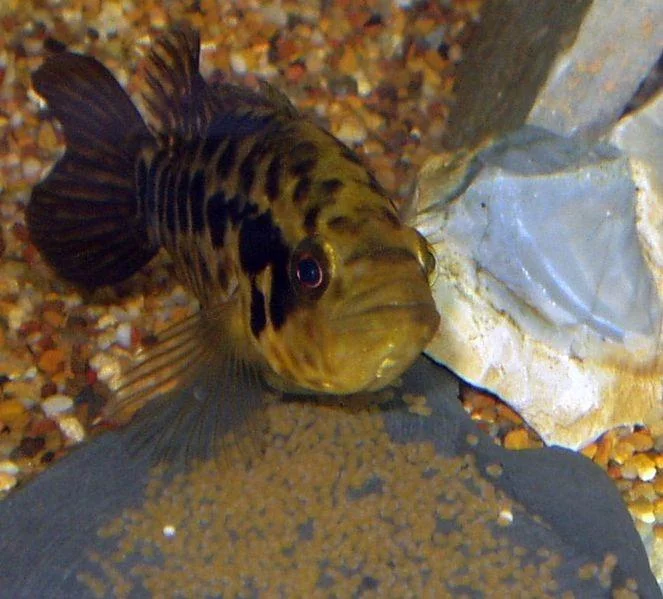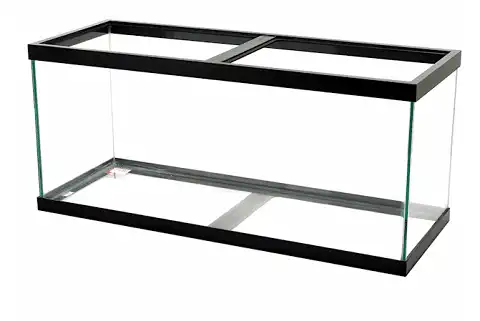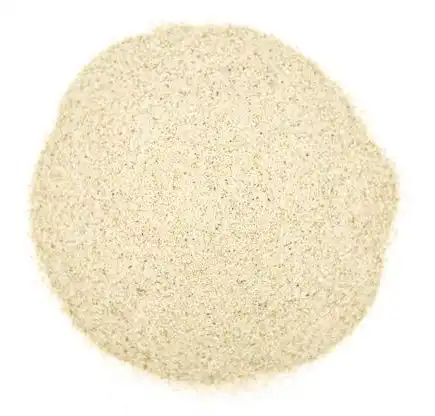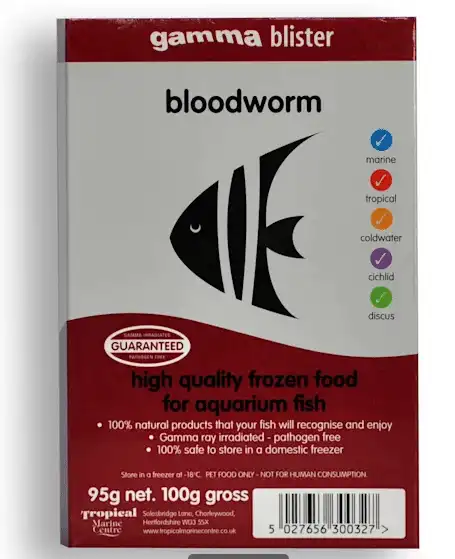Thank you for visiting! By the way… any links on this page that lead to products on Amazon and other stores/partners are affiliate links Aquarium Store Depot earns a commission if you make a purchase.
Are you in search of an energetic, colorful addition to your fish tank that’s easy-to-care for? Then the Firemouth Cichlid might be just what you need! These Thorichthys meeki are bold and will send a statement in your tank. Here we will explore all there is to know about these fiery fish – from their natural habitat, coloration, aquatic needs and food preferences through to their social behavior, and will give you the information needed to decide if this striking species should become part of your underwater world.
Key Takeaways
- Firemouth cichlids are a popular freshwater fish with vibrant coloration and adaptability.
- They are large and aggressive fish that need extra consideration on tankmate selection
- Provide them with an ideal environment, water conditions, diet & tankmates for successful breeding.
- Firemouth cichlids make interesting additions to any aquarium due to their omnivorous diet & rearranging of decorations!
Species Overview
| Scientific Name | Thorichthys meeki |
| Common Names | Firemouth Cichlid |
| Family | Cichlidae |
| Origin | Central America, particularly the Yucatan Peninsula |
| Diet | Omnivorous |
| Care Difficulty | Easy |
| Activity | Active |
| Life Expectancy | 10 – 15 years |
| Temperament | Semi-aggressive |
| Tank Level | Middle to bottom |
| Minimum Tank Size | 40 gallons (151 liters) for a pair |
| Temperature Range | 75-86°F (24-30°C) |
| Water Hardness | 8-15 dKH |
| pH Range | 6.5 – 8.0 |
| Filtration/Water Flow | Moderate |
| Water Type | Freshwater |
| Breeding | Egg layer |
| Difficulty to Breed | Easy to moderate |
| Compatibility | Best with similarly sized fish that aren’t overly aggressive |
| OK, for Planted Tanks? | Yes, but can dig them out |
Introduction
The Firemouth cichlid are fish which inhabit Central America and have grown popular in the aquarium trade due to their hardiness. They’re native freshwater species, part of the same family as African cichlids but known for being more mild tempered (but still aggressive compared to many community fish) than them.
They typically reside in slow moving rivers or streams within the Yucatan Peninsula’s warm shallow waters where they can adjust themselves well even when conditions alter. To create an optimal setting for these amazing creatures, we should carefully investigate their origins and natural habitat so that it is accurately reflected inside your tank!
Origins And Habitat
The wild Firemouth cichlids are native to the rivers of Mexico’s Yucatan Peninsula, Belize and Guatemala. These fish live in slow-moving streams with a variety of substrates like sand, mud or limestone that can be either clear or cloudy depending on their salinity levels ranging from freshwater to brackish water. In terms of vegetation, they thrive best without dense foliage but rather underpopulated areas filled mostly by different algae species instead.
When setting up an aquarium for your Firemouth Cichlid, it is important to keep temperature between 23-30°C (75-86°F) and pH level at 6.5–8. Replicating as much as possible their natural habitat will guarantee them good health and quality life while living in captivity.
Appearance

When it comes to aquarium inhabitants, firemouth cichlids certainly have a unique look that stands out from the rest! These active fish feature greyish-green hues on their bodies with darker stripes and red/orange colors under their bellies as well as near the base of its gill cover. During spawning season, this fiery hue grows even more pronounced alongside an increase in aggression towards other species.
Usually found cruising through midwater areas, these curious creatures can be seen socializing with one another when living together, which is why knowing males’ and females’ differences are paramount for successful breeding conditions within the tank environment.
Size And Growth
The firemouth cichlid, when cared for properly, has a lifespan of up to 10 years. This species is typically quite slow growing and will take 4-5 years before reaching its full potential size of 6-7 inches in males and around 4-5 inches for females.
Tank Size And Requirements
When housing firemouth cichlids, a minimum tank size of 40 gallons is recommended for keeping them in pairs. To keep with other fish species, it’s best to go with at least 55 gallons. A rectangular shaped container will provide adequate swimming space and create a more natural atmosphere, essential factors when caring for these vibrant creatures!
The 55-gallon aquarium is a great budget-friendly larger tank. It often goes on sale at chain pet stores.
It’s necessary to maintain slow water flow as the motion can be too much for this particular type of cichlid and cause stress. So opt-in favor if using an appropriate filter system such as one designed specifically with slower speeds in mind or one that can be adjusted (e.g., canister filters).
As far as lighting conditions are concerned, choose between 10,000K white light that contains blue wavelengths along some RGB light spectrum features which should prove beneficial. Remember though: If you’re planning on adding additional animals, then 5-10 extra gallon tanks per new entry would be highly favorable elements towards achieving optimal living conditions inside its abode!
Water Parameters
Firemouth cichlids, which are tropical fish species, require the right water parameters to thrive. The suggested temperature range is between 70-82°F (21.1, 27.8 °C), pH should be within 6.5 and 8. And the hardness of 8-15dGH makes for the best environment for these creatures. Consequently, a dependable filtration system must also be established in order to prevent harmful substances from harming your firemouths— such as monthly filter media cleanings with your tank water and biweekly water changes help protect their health tremendously!
Decor Tips
It is essential for the well-being of firemouth cichlids to maintain a natural and comfortable environment. Try incorporating driftwood, rocks and decorations that give them places to hide, all things necessary in helping these fish feel secure (and their aggression down). A sandy substrate mixed with bigger smoothed stones would make an excellent area for your cichlid’s exploration needs too! Make sure water flow remains at a low level while still enabling plenty of oxygenation throughout their habitat.
Natural sand is excellent for bottom feeder fish to forage around in.
Feeding
Firemouth cichlids eat a wide selection of food, including live, frozen and dried items. It’s essential that they get fed every two days, but with no more than what can be eaten in 1 minutes to avoid health problems caused by leftover material in the water.
Frozen bloods are a great source of protein and a fish source fish naturally respond to. Very filling and works for just about any fish
The staple diet should include fish flakes or pellets plus sometimes some blanched vegetables along with protein-rich frozen treats such as brine shrimp or bloodworms. All leftovers must be removed from their environment. If you have bottom feeders like Plecos in the tank you might be able to get by with leftover fish food, but still keep an eye on your nutrient levels. Keep several types of foods available so they can maintain a varied diet.
Social Behavior And Compatibility
Firemouth cichlids are typically peaceful, so they can peacefully coexist with other non-aggressive freshwater fish that match their size. During the spawning period though, territorial behavior and aggressiveness might appear. It’s important to monitor your tank inhabitants carefully in order not to get into trouble.
Good Tank Mates

When picking Firemouth Cichlid tank mates to accompany your firemouth cichlids in the aquarium, you need to select species of similar size and temperament.
Some good choices for compatible Firemouth Cichlid tank mates include:
- Severum Cichlid
- Blood Parrot fish species
- Yoyo Loaches
- Jack Dempsey
- Convict Cichlids
- Green Terrors
- Electric Blue Acara
- Geophages Cichlids
- Denison Barb
- Pleco fish
The Silver Dollar is also a great choice has a dither fish that can bring out your Firemouth Cichlid.
When considering stocking any tank housing firemoth cichildes one must ensure ample space is available as well, this will provide enough swimming room needed even when mixing various kinds of fish there!
Tank Mates To Avoid

Firemouth cichlids can be aggressive towards smaller freshwater fish. Tiny schooling fish such as tetras and rasboras should not be kept alongside firemouths since they could end up becoming their dinner. Shrimp or freshwater snails are unsuitable companions for these cichlids because they usually munch on them without warning. There are also more aggressive species that would be a bad choice. Here are a few bad tank mates:
- Jaguar Cichlids
- Midas
- Red Devils
- Most African Cichlids
It is important that the compatibility among inhabitants in your aquarium is taken into account so that a peaceful atmosphere remains intact and stress-free for all the fish involved.
Breeding Practices And Parental Care
The Firemouth Cichlid is known to form monogamous partnerships and reproduce independently. During breeding, the female can lay up to 500 eggs that will be fertilized by her mate. Both parents then work together in providing care for their eggs as well as protecting young fry until they become big enough to fend for themselves (video source).
Creating an appropriate habitat, abiding water quality conditions desirable according to diet needs all contribute high probability rates when it comes your firemouth cichlid breeding. Making sure these elements remain ideal will undoubtedly have a positive influence within every step leading up to successful breeding efforts.
Flat surfaces are best to use for breeding as the eggs will stick to these surfaces once the Firemouth Cichlid female lays its eggs. Rocks such as slate or even ceramic tile are great to use as a breeding ground.
Great price and selection. Small world offers an affordable solution for quality aquarium slate
Male And Female Differences
For successful breeding and a healthy tank environment, it is important to recognize the differences between male and female firemouth cichlid. The male Firemouth Cichlid will have more intense red-orange coloration plus longer dorsal and anal fins with sharp tips. By comparison, females are not as vibrant in hue, but they do possess rounder genital papillae. These two distinctions make it easier for aquarists to distinguish one from the other.
Unfortunately, as juveniles, it is hard to tell. These differentiating features become more obvious as the fish grows into adulthood.
Health Concerns And Disease Prevention
Firemouth cichlids, like other fish species, may suffer from health complications. These could be bacterial or fungal infections as well as Ich, a parasitic infection which is characterized by white spots on the fins and gills of the affected fishes. If this happens to your Firemouth Cichlid, raising tank water temperature up to 86°F can help treat it along with specific medications for treating Ich if needed.
To maintain healthy firemouth cichlid conditions and avoid illnesses in general, ensure that you keep their environment clean at all times through monthly filter media cleaning and biweekly water changes while also maintaining optimal pH levels alongside correct dGH amounts and temperatures necessary for survival within the aquarium ecosystem. Here are other parameters to keep in mind:
Providing them with a balanced diet along with ensuring they are not stressed out will aid greatly in keeping your colorful fish safe too!
Firemouth Cichlid As An Invasive Species
Firemouth cichlids have a great appeal, but they are considered an invasive species in areas outside of their native Central America. Invasive aquatic creatures can be damaging to local ecosystems by replacing existing wildlife and upsetting the environmental equilibrium.
Fish keepers should take responsibility for preventing fish diseases. Spread of firemouth cichlids while protecting natural habitats with careful consideration when selecting fish sources to maintain a healthy aquarium environment. This means never releasing any tank inhabitants into nature and sourcing only from trusted suppliers.
Fun Facts About Firemouth Cichlids
Firemouth cichlids have a diet that is both omnivorous and crustacean based, with the occasional plant nibble. They are also remarkable interior designers as they often move around decorations in their tanks to suit them best. Don’t fall in love too much with your aquascaping, as your Firemouth will happily rearrange everything over time!
These fish display captivating social behavior. Being monogamous creatures who pair up for life makes it an attractive addition to any aquarium. Firemouths provide intriguing characteristics due to their unique dietary habits and strong loyalty amongst partners, resulting in fascinating entertaining inhabitants of your tank!
Frequently Asked Questions
Are firemouth cichlids aggressive?
Firemouth cichlids can become very aggressive during mating periods, especially in aquariums where there is not enough space or hiding areas. To keep these fish together peacefully, it’s essential to give them sufficient room and retreat options.
Can I keep 2 firemouth cichlids together?
Keeping two Firemouth Cichlids together is possible in a properly sized tank. A 30-gallon aquarium should be enough space for the pair of them and their nonaggressive fish companions to thrive harmoniously. It’s recommended to get a set of these colorful freshwater cichlids and create an enjoyable home environment they will both enjoy.
How many firemouth cichlids in a tank?
When it comes to Firemouth Cichlids, a tank of at least 30 gallons is recommended if you plan on housing them in pairs. This gives the fish adequate space and prevents any struggles for food or resources from developing. Be sure that their environment remains healthy by appropriately caring for your tank as well as monitoring size and activity levels of the cichlids inside.
Are firemouth cichlids aggressive?
When it comes to defending their territories, Firemouth cichlids can be quite aggressive. With other types of cichlid species. Keeping them with similar sized fish is recommended as they are large fish. More peaceful than most. To ensure a stress-free environment for the fish, providing numerous hideaways within an aquarium setting is encouraged too.
Can I keep 2 firemouth cichlids together?
It is possible to keep two firemouth cichlids together, provided they have adequate tank size and are not provoked. A minimum of 30-gallon aquarium capacity should be maintained for a pair of this species. It would also be beneficial to select non-aggressive fish as companion tank mates in order to avoid any conflict between the Firemouths themselves or with other inhabitants.
Closing Thoughts
For the adventurous fish keeper, firemouth cichlids are an alluring option for their tanks. These stunningly vibrant creatures come with unique characteristics that must be taken into account when considering them as part of your aquatic family. These include habitats, looks and behaviors like feeding habits and social tendencies.
With proper care to provide a comfortable environment meeting their specific needs while also taking on beginner or experienced levels of difficulty, they will surely make a colorful addition to any aquarium community! Firemoth cichlids need not seem intimidating though, because by understanding what it takes for them to thrive you can ensure that each one is kept happy in its new fiery home.
Kept this freshwater fish before? Let us know your experience in the comments below!
- About the Author
- Latest Posts
I’m thrilled that you found Aquarium Store Depot! Here you’ll find information on fish, aquariums, and all things aquatics related. I’m a hobbyist (being doing this since I was 11) and here to help other hobbyists thrive with their aquariums! I adhere to a high quality Editorial Process and Review products with real life field usage and practical analysis.









